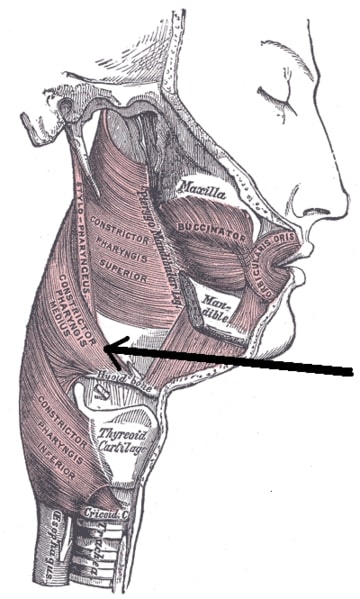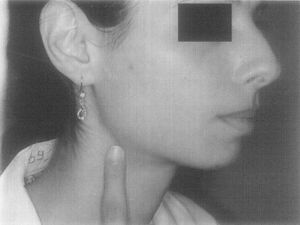Hyoid Bone Syndrome

| |
| Hyoid Bone Syndrome | |
|---|---|
| Epidemiology | Rare |
| Pathophysiology | Calcification and inflammation of the muscles that insert onto the hyoid bone. |
| Clinical Features | Anterolateral neck pain with jaw movement, neck movement, or swallowing. Tenderness over the greater cornu of the hyoid bone. |
| Tests | Diagnostic local anaesthetic into the stylohyoid attachment to the hyoid bone. |
| Treatment | NSAIDs, corticosteroid injection |
Hyoid bone syndrome, also known as hyoid syndrome, is neck and jaw movement related anterolateral neck pain arising from the degenerative change of the muscles that insert onto the greater cornu of the hyoid bone.
Anatomy
- Main article: Hyoid
The hyoid bone is fixed only by ligaments and muscles and is the only bone that doesn't directly articulate with another bone (a tensegrity structure). It lies between the root of the tongue and thyroid cartilage.
It is suspended by a total of 9 muscles that elevate, depress, protract, and retract it. The middle pharyngeal constrictor muscle inserts onto the greater cornu. The stylohyoid ligament also attaches to the styloid process superiorly, and to the hyoid bone inferiorly.
With respiration, swallowing, and phonation is has a rocking motion. The digastric muscle inserts centrally and acts as a fulcrum. With expiration the hyoid rises, and with inspiration it falls. With swallowing it also falls.[1]
The stylohyoid complex has much variability. Variations include an elongated styloid process, ossified stylohyoid ligament, and an elongated hyoid bone.
Pathophysiology
It is thought to result from tendinitis or tendinosis of the muscles that insert onto the hyoid bone. One study found focal degenerative changes of the middle constrictor muscle where it insert on the hyoid bone.[2].
Clinical Features

History
Sharping and stabbing pain that comes on with jaw movement, chewing, ipsilateral neck rotation, or swallowing. The pain is felt below the angle of the mandible and radiates to the anterolateral neck and ipsilateral ear. Dysphonia may be an additional complaint. Patients may occasionally complain of a foreign body sensation in their throat and dysphonia.[4]
Cerebrovascular ischaemia can occur with injury to the carotid artery and jugular vein. One case described sympathetic symptoms.[5]
Examination
On examination there is tenderness at the tip of the greater hyoid cornu. Passive accessory motion from side to side with the thumb on one side and index finger on the other of the greater cornua elicits pain or foreign body sensation.
Differential Diagnosis
- Gastro-oesophageal reflux and laryngo-oesophageal reflux
- Soft tissue injuries
- Occult cervical spine fracture or instability
- Tumours of the neck, hypopharynx, or lung apex.
- Sialadenitis
- Odontogenic pain
- Temporomandibular Dysfunction
- Ernest Syndrome
- Eagle's Syndrome
- Carotid artery syndrome
- Hyoid Bone Syndrome
- Superior Pharyngeal Constrictor Syndrome
- Omohyoid Syndrome
- Hyoid muscle dystonia
- Oesophageal tear
- Thyroglossal duct cyst
- Glossopharyngeal Neuralgia
Glossopharyngeal neuralgia is characterised by paroxysms of shooting pains similar to trigeminal neuralgia, and is associated with cardiac bradyarrhythmias. While in hyoid syndrome the pain occurs with movement.
See Differential Diagnosis of Anterior Throat pain and article by Shankland for distinguishing some of these conditions.[6]
Investigations
Workup may include endoscopy and CT or MRI to exclude other causes.
Diagnostic Block
Injection of local anaesthetic into the attachment of the stylohyoid ligament to the greater cornu of the hyoid bone. Abolition of pain supports the diagnosis. Corticosteroid can be added for an additional therapeutic effect.
Diagnosis
Hyoid syndrome is a diagnosis of exclusion. Tumours should in particular first be excluded.
Treatment
Medication
NSAIDs can have a good effect.[3]
Injection
If symptoms persist then corticosteroid injection of the inferior attachment of the stylohyoid ligament onto the greater cornu of the hyoid bone can be done. A large cohort study found 74% had complete resolution with 1-5 injections. 54% had complete response after 1 injection, and a further 14% with 2 injections. There was a partial response in a further 15%, and no response in 10%.[4]
Use a 25-gauge needle with 40mg triamcinolone. The target point is 2-3cm inferior to the angle of the mandible. Stabilise the hyoid bone with bidigital palpation of the greater cornua. Insert the needle at this point perpendicular to the skin. Advance until the hyoid bone is hit which should be 2.5-3cm deep. Withdraw slightly out of the periosteum or calcified ligament. Aspirate and then inject. Ultrasound guidance can improve the accuracy of injection.
If the needle is placed incorrectly then damage can occur to the brachial plexus, phrenic nerve, recurrent laryngeal nerve, and central neuroaxial structures. There is also the potential for epidural, subdural, or subarachnoid injection. Pneumothorax can also occur. The internal carotid artery is also nearby and injection of anaesthetic here can result in toxicity and seizures.
Surgery
In recalcitrant cases the greater hyoid cornu can be resected.[1]
Miscellany
The syndrome was described in 1954 by Brown as a complex of neck and throat pain on swallowing and neck movement along with tenderness at the tip of the greater hyoid cornu.[7]
Further Reading
- Hyoid Bone Syndrome (practicalpainmanagement.com)
 Shankland WE 2nd. Anterior throat pain syndromes: causes for undiagnosed craniofacial pain. Cranio. 2010 Jan;28(1):50-9. doi: 10.1179/crn.2010.007. PMID. Full Text
Shankland WE 2nd. Anterior throat pain syndromes: causes for undiagnosed craniofacial pain. Cranio. 2010 Jan;28(1):50-9. doi: 10.1179/crn.2010.007. PMID. Full Text
References
- ↑ 1.0 1.1 Lim, R. Y. (1982-03). "The hyoid bone syndrome". Otolaryngology--Head and Neck Surgery: Official Journal of American Academy of Otolaryngology-Head and Neck Surgery. 90 (2): 198–200. doi:10.1177/019459988209000211. ISSN 0194-5998. PMID 6810265. Check date values in:
|date=(help) - ↑ Ernest E, Salter E. Hyoid Bone Syndrome. Pract Pain Manag. 2006;6(8). Full Text
- ↑ 3.0 3.1 Nir, D.; Hefer, T.; Joachims, H. Z. (1998-09). "Hyoid bone syndrome and its treatment with nonsteroidal anti-inflammatory drugs". American Journal of Otolaryngology. 19 (5): 296–300. doi:10.1016/s0196-0709(98)90001-1. ISSN 0196-0709. PMID 9758176. Check date values in:
|date=(help) - ↑ 4.0 4.1 Stern, Noah; Jackson-Menaldi, Cristina; Rubin, Adam D. (2013-03). "Hyoid bone syndrome: a retrospective review of 84 patients treated with triamcinolone acetonide injections". The Annals of Otology, Rhinology, and Laryngology. 122 (3): 159–162. doi:10.1177/000348941312200303. ISSN 0003-4894. PMID 23577567. Check date values in:
|date=(help) - ↑ Wang, Rongfei; Yuan, Huijuan; Dong, Zhao (2021-06-01). "Hyoid Bone Syndrome With Sympathetic Symptoms". JAMA neurology. 78 (6): 757–758. doi:10.1001/jamaneurol.2021.0750. ISSN 2168-6157. PMID 33871556.
- ↑ Shankland, Wesley E. (2010-01). "Anterior throat pain syndromes: causes for undiagnosed craniofacial pain". Cranio: The Journal of Craniomandibular Practice. 28 (1): 50–59. doi:10.1179/crn.2010.007. ISSN 0886-9634. PMID 20158009. Check date values in:
|date=(help) - ↑ Brown, L. A. (1954-11). "Hyoid bone syndrome". Southern Medical Journal. 47 (11): 1088–1091. doi:10.1097/00007611-195411000-00013. ISSN 0038-4348. PMID 13205302. Check date values in:
|date=(help)
Literature Review
- Reviews from the last 7 years: review articles, free review articles, systematic reviews, meta-analyses, NCBI Bookshelf
- Articles from all years: PubMed search, Google Scholar search.
- TRIP Database: clinical publications about evidence-based medicine.
- Other Wikis: Radiopaedia, Wikipedia Search, Wikipedia I Feel Lucky, Orthobullets,


